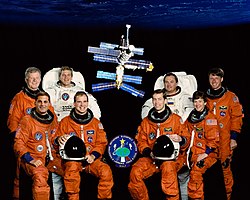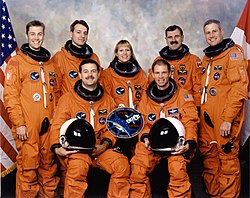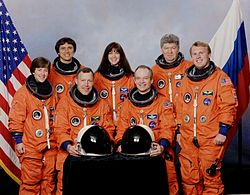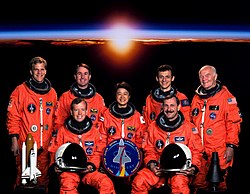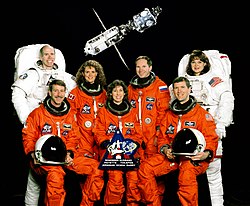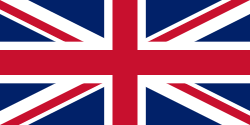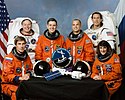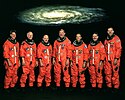Seznam pilotovaných vesmírných letů 1987–1999
3Podrobný seznam pilotovaných letů od roku 1987 do 1999, zahrnující ruskou vesmírnou stanici Mir a americké raketoplány Space Shuttle po havárii Chalengeru.
Média použitá na této stránce
Při zobrazení tohoto souboru lze snadno přidat orámování
Při zobrazení tohoto souboru lze snadno přidat orámování
Flag of Canada introduced in 1965, using Pantone colors. This design replaced the Canadian Red Ensign design.
STS-28 mission patch
- The STS-28 insignia was designed by the astronaut crew, who said it portrays the pride the American people have in their manned spaceflight program. It depicts America (the eagle) guiding the space program (the Space Shuttle) safely home from an orbital mission. The view looks south on Baja California and the west coast of the United States as the space travelers re-enter the atmosphere. The hypersonic contrails created by the eagle and Shuttle represent the American flag. The crew called the simple boldness of the design symbolic of America's unfaltering commitment to leadership in the exploration and development of space.
STS-29 Mission Insignia
The STS-29 patch was designed to capture and represent the energy and dynamic nature of this nation's space program as America continues to look to the future. The folded ribbon border, the first of its kind in the Shuttle patch series, gives a sense of three dimensional depth to the emblem. The stylistic orbital maneuvering system (ONS) burn symbolizes the powerful forward momentum of the Shuttle and a continuing determination to explore the frontiers of space. The colors of the U.S. flag are represented in the patch's basic red, white, and blue background. In the border, the seven stars between the STS-29 crew names are a tribute to the crew of Challenger.
STS-27 Mission Insignia
The STS-95 patch, designed by the crew, is intended to reflect the scientific, engineering, and historic elements of the mission. The Space Shuttle Discovery is shown rising over the sunlit Earth limb, representing the global benefits of the mission science and the solar science objectives of the Spartan Satellite. The bold number '7' signifies the seven members of Discovery's crew and also represents a historical link to the original seven Mercury astronauts. The STS-95 crew member John Glenn's first orbital flight is represnted by the Friendship 7 capsule. The rocket plumes symbolize the three major fields of science represented by the mission payloads: microgravity material science, medical research for humans on Earth and in space, and astronomy.
Designed by the crew members, this patch commemorates the first assembly flight to carry United States-built hardware for constructing the International Space Station (ISS). This flight's primary task is to assemble the cornerstone of the Space Station: the Node with the Functional Cargo Block (fgb). The rising sun symbolizes the dawning of a new era of international cooperation in space and the beginning of a new program: the International Space Station. The Earth scene outlines the countries of the Station Partners: the United States, Russia, those of the European Space Agency (ESA), Japan, and Canada. Along with the Pressurized Mating Adapters (PMA) and the Functional Cargo Block, the Node is shown in the final mated configuration while berthed to the Space Shuttle during the STS-88/2A mission. The Big Dipper Constellation points the way to the North Star, a guiding light for pioneers and explorers for generations. In the words of the crew, "These stars symbolize the efforts of everyone, including all the countries involved in the design and construction of the International Space Station, guiding us into the future."
The official crew patch for the Russian Soyuz TM-20 mission, which delivered the EO-17 crew to the space station Mir.
* In the STS-89 crew insignia, the link between the United States and Russia is symbolically represented by the Space Shuttle Endeavour and Russia's Mir Space Station orbiting above the Bering Strait between Siberia and Alaska. The success of the joint United States-Russian missions is depicted by the Space Shuttle and Mir colored by the rising sun in the background.
- A shadowed representation of the International Space Station (ISS) rising with the sun represents the future program for which the Shuttle-Mir missions are prototypes. The inside rim of the insignia describes the outline of the number eight representing STS-89 as the eighth Shuttle/Mir docking mission.
- The nine stars represent the nine joint missions to be flown of the program and when combined with the number eight in the rim, reflect the mission number. The nine stars also symbolize the children of the crew members who will be the future beneficiaries of the joint development work of the space programs of the two countries.
- Along the rim are the crew members' names with David A. Wolf's name on the left and Andrew S. W. Thomas' name on the right, the returning and upgoing cosmonaut guest researcher crew members. In between and at the bottom is the name of Salizan S. Sharipov, payload specialist representing Russian Space Agency (RSA), in Cyrillic alphabet.
- The other crew members are Terrence W. Wilcutt, commander; Joe F. Edwards, Jr., pilot; and mission specialists Michael P. Anderson, Bonnie J. Dunbar, and James F. Reilly. The red, white and blue of the rim reflect the colors of the American and Russian flags which are also represented in the rim on either side of the joined spacecraft.
Five astronauts based at the Johnson Space Center (JSC) and two payload specialists take a break from their training schedule to pose for the STS-95 pre-flight portrait. Seated are astronauts Curtis L. Brown Jr. (right), mission commander; and Steven W. Lindsey, pilot. Standing, from the left, are Scott F. Parazynski and Stephen K. Robinson, both mission specialists; Chiaki Mukai, payload specialist representing Japan's National Space Development Agency (NASDA); Pedro Duque, mission specialist representing the European Space Agency (ESA); and U.S. Sen. John H. Glenn Jr., payload specialist. The seven are scheduled to be launched into Earth orbit aboard the Space Shuttle Discovery in late October of this year.
The crew assigned to the STS-71 mission included (front left to right) Vladimir N. Dezhurov, Mir 18 crew download; Robert L. Gibson, commander; and Anatoly Y. Solovyev, Mir 19 crew upload. On the back row, left to right, are Norman E. Thagard, Mir 18 crew download; Gennadiy Strekalov, Mir 18 crew download; Gregory J. Harbaugh, mission specialist; Ellen S. Baker, mission specialist; Charles J. Precourt, pilot; Bonnie J. Dunbar, mission specialist; and Nikolai Budarin, Mir 19 crew upload. Launched aboard the Space Shuttle Atlantis on June 27, 1995 at 3:32:19.044 pm (EDT), the STS-71 mission marked many firsts in human space flight history. It was the first U.S. Space Shuttle-Russian Space Station Mir docking and joint on-orbit operations, and the first on-orbit change out of a shuttle crew. In addition, it was the largest spacecraft ever in orbit and was the 100th U.S. human space launch conducted from the Cape.
Six NASA astronauts and a Russian cosmonaut take a break from training to pose for the STS-96 crew portrait. Astronaut Kent V. Rominger, mission commander, is at left on the front row. Astronaut Rick D. Husband, right, is pilot. The mission specialists are Ellen Ochoa (front center) and, from the left on the back row, Daniel T. Barry, Julie Payette, Valeriy I. Tokarev and Tamara Jernigan. Payette represents the Canadian Space Agency (CSA) and Tokarev is with the Russian Space Agency (RSA). The crew will perform the first station docking and will become the first visitors to the new International Space Station since its launch and start of orbital assembly last year. Discovery's launch date is now scheduled for May 20.
The five astronauts assigned to fly aboard the Space Shuttle Columbia early next year for the STS-93 mission pose with a small model of their primary payload-the Advanced X-ray Astrophysics Facility (AXAF). Collins, mission commander; Steven A. Hawley, mission specialist; Jeffrey S. Ashby, pilot; Michel Tognini and Catherine G. Coleman, both mission specialists. Tognini represents France's Centre National d'Études Spatiales (CNES). The scheduled five-day mission will feature the deployment of AXAF, which will enable scientists to conduct comprehensive studies of exotic phenomena in the universe. Among bodies studied will be exploding stars, quasars and black holes.
The STS-86 flight was the seventh shuttle-Mir docking mission, symbolized by seven stars. The international crew includes astronauts from the United States, Russia, and France. The flags of these nations are incorporated in the rays of the astronaut logo. The rays of light streaking across the sky depict the orbital tracks of the two spacecraft as they prepare to dock. During the flight, an American astronaut and a Russian cosmonaut will perform an extravehicular activity (EVA). The mercator projection of Earth illustrates the global cooperative nature of the flight.
STS-91 CREW INSIGNIA (March 1998) --- This is the crew patch for the STS-91 mission -- the ninth flight of the Shuttle-Mir Phase One docking missions. The crew will bring back Andrew S. W. Thomas, the last long-duration American crew member flown on the Russian Space Station Mir. This mission marks the end of the Shuttle-Mir Phase One Program and will open the way for Phase Two: construction of the International Space Station (ISS). The crew patch depicts the rendezvous of the Space Shuttle Discovery with the Space Station Mir. The flags of the United States and Russia are displayed at the top of the patch and both countries are visible on the Earth behind the two spacecraft. The names of the American crew members surround the insignia on the outer areas, with the name of cosmonaut Valery Ryumin in Cyrillic at the lower right. The Alpha Magnetic Spectrometer (AMS) is an international payload planned to fly in the payload bay of Discovery. Two thin golden streams flowing into the AMS represent charged elementary particles. The detection of antimatter in space will help scientists better understand the physics and origins of the universe.
STS089-S-002 (Oct. 1997) --- These seven astronauts and one cosmonaut represent the flight crew for the STS-89 mission to Russia?s Mir Space Station. On the front row, from the left, are astronauts Joe F. Edwards, Jr., pilot; Terrence W. Wilcutt, commander; and Bonnie J. Dunbar, mission specialist. On the back row are David A. Wolf, currently onboard the Mir Space Station as a cosmonaut guest researcher; Salizan S. Sharipov, mission specialist representing the Russian Space Agency (RSA); James F. Reilly, mission specialist; Andrew S. W. Thomas, replacing Wolf aboard Mir as cosmonaut guest researcher; and Michael P. Anderson, mission specialist.
The official crew patch for the Russian Soyuz TM-28 mission, which delivered the EO-26 crew to the space station Mir.
Five astronauts and two payload specialists take a break in training for the Neurolab mission to pause for a crew portrait. The Spacelab mission was conducted aboard the Space Shuttle Columbia on STS-90 which launched on April 17, 1998. Astronauts Richard A. Searfoss, commander (right front); and Scott D. Altman, pilot (left front). Other crew members (back row, left to right) are James A. (Jim) Pawelczyk, Ph.D., payload specialist; and astronauts Richard M. Linnehan, Kathryn P. Hire, and Dafydd R. (Dave) Williams, all mission specialists; along with payload specialist Jay C. Buckey, Jr., MD. Linnehan and Williams, alumnus of the 1995 class of astronaut candidates (ASCAN), represents the Canadian Space Agency (CSA).
Designed by the crew members, this is the mission insignia for the STS-96 space flight, the second Space Shuttle mission dedicated to the assembly of the International Space Station (ISS). The crew patch highlights the major themes of the Station Program: Earth-directed research, the advancement of human space exploration, and international cooperation. The Space Shuttle Discovery is depicted shortly after reaching orbit as the crew prepares to carry out the first docking with the new Station. At this early stage in its construction, ISS consists of two modules: Zarya and Unity, shown orbiting Earth. The triangular shape of the patch represents building on the knowledge and experience of earlier missions, while the three vertical bars of the astronaut emblem point toward future human endeavors in space. The five-pointed star that tops the astronaut emblem in this depiction is symbolic of the five space agencies participating in the development of ISS: NASA, the Russian Space Agency, the European Space Agency, the National Space Development Agency of Japan, and the Canadian Space Agency. The blend of red, white, and blue is a tribute to the nationalities of the crew members who are from the United States, Canada, and Russia.
STS-71 Mission Insignia
The STS-71 crew patch design depicts the orbiter Atlantis in the process of the first international docking mission of the Space Shuttle Atlantis with the Russian Space Station Mir. The names of the 10 astronauts and cosmonauts who flew aboard the orbiter are shown along the outer border of the patch. The rising sun symbolizes the dawn of a new era of cooperation between the two countries. The vehicles Atlantis and Mir are shown in separate circles converging at the center of the emblem symbolizing the merger of the space programs of the two space faring nations. The flags of the United States and Russia emphasize the equal partnership of the mission. The joint program symbol at the lower center of the patch acknowledges the extensive contributions made by the Mission Control Centers (MCC) of both countries. The crew insignia was designed by aviation and space artist, Bob McCall, who also designed the crew patch for the Apollo Soyuz Test Project (ASTP) in 1975, the first international space docking mission.
STS-86 crew
STS-90 insignia
- The STS-90 crew patch reflects the dedication of the mission to neuroscience in celebration of the decade of the brain. Earth is revealed through a neuron-shaped window, which symbolizes new perspectives in the understanding of nervous system development, structure and function, both here on Earth and in the microgravity environment of space.
- The Space Shuttle Columbia is depicted with its open payload bay doors revealing the Spacelab within. An integral component of the mission, the laboratory/science module provided by the European Space Agency (ESA), signifies the strong international involvement in the mission. The seven crew members and two alternate payload specialists, Chiaki Naito-Mukai and Alexander W. Dunlap, are represented by the nine major stars of the constellation Cetus (the whale) in recognition of the International Year of the Ocean.
- The distant stars illustrate the far reaching implications of the mission science to the many sponsoring agencies, helping prepare for long-duration space flight aboard the International Space Station (ISS).
- The moon and Mars are depicted to reflect the crew's recognition that those two celestial bodies will be the next great challenges in human exploration of space and represent the key role that life science research will play in supporting such missions.
The STS-30 patch depicts the joining of NASA's manned and unmanned space programs. The sun and inner planets of our solar system are shown with the curve connecting Earth and Venus symbolizing the shuttle orbit, the spacecraft trajectory toward Venus, and its subsequent orbit around our sister planet. A Spanish caravel similar to the ship on the official Magellan program logo commemorates the 16th century explorer's journey and his legacy of adventure and discovery. Seven stars on the patch honor the crew of Challenger. The five-star cluster in the shape of the constellation Cassiopeia represent the five STS-30 crewmembers - Astronauts David Walker, Ronald Grabe, Norman Thagard, Mary Cleave and Mark Lee - who collectively designed the patch.
The official crew patch for the Russian Soyuz TM-21 mission, which delivered the EO-18 crew to the space station Mir.
STS088(S)002 (November 1998):
Five NASA astronauts and a Russian cosmonaut assigned to the STS-88 mission, scheduled for an early December launch, take time out from their busy training agenda for a crew portrait. Seated in front are Sergei K. Krikalev, a mission specialist representing the Russian Space Agency (RSA), and astronaut Nancy J. Currie, mission specialist. In the rear, from the left, are astronauts Jerry L. Ross, mission specialist; Robert D. Cabana, mission commander; Frederick W. Sturckow, pilot; and James H. Newman, mission specialist.STS-91 CREW PORTRAIT (January 1998) --- The final crew members scheduled to visit Russia's Mir Space Station pose for a crew portrait during training at the Johnson Space Center (JSC). Pictured with their helmets in front are astronauts Dominic C. Gorie (left) and Charles J. Precourt. Others, from the left, are Wendy B. Lawrence, Franklin R. Chang-Diaz, Janet L. Kavandi, Valeriy V. Ryumin and Andrew S. W. Thomas. Precourt is mission commander, and Gorie, pilot, for Discovery's summer 1998 mission to Mir. Thomas, who will have been serving as a guest researcher on Mir since late January, will return to Earth with the crew members. Lawrence, Chang-Diaz, Kavandi and Ryumin are all mission specialists. Ryumin represents the Russian Space Agency (RSA). Discovery will carry the single module version of Spacehab for the scheduled nine-day mission.
Designed by the crewmembers, the STS-103 emblem depicts the Space Shuttle Discovery approaching the Hubble Space Telescope (HST) prior to its capture and berthing. The purpose of the mission is to remove and replace some of the Telescope's older and out-of-date systems with newer, more reliable and more capable ones, and to make repairs to HST's exterior thermal insulation that has been damaged by more than nine years of exposure to the space environment. The horizontal and vertical lines centered on the Telescope symbolize the ability to reach and maintain a desired attitude in space, essential to the instrument's scientific operation. The preservation of this ability is one of the primary objectives of the mission. After the flight, the Telescope will resume its successful exploration of deep space and will continue to be used to study solar system objects, stars in the making, late phases of stellar evolution, galaxies and the early history of the universe. HST, as represented on this emblem was inspired by views from previous servicing missions, with its solar arrays illuminated by the Sun, providing a striking contrast with the blackness of space and the night side of Earth.
- The NASA insignia design for Shuttle flights is reserved for use by the astronauts and for other official use as the NASA Administrator may authorize. Public availability has been approved only in the form of illustrations by the various news media. When and if there is any change in this policy, which is not anticipated, it will be publicly announced.
The predominant themes are: a new beginning (sunrise), a safe mission (stylized launch and plume), the building upon the traditional strengths of NASA (the red vector which symbolizes aeronautics on the original NASA insignia), and a remembrance of their seven colleagues who died aboard Challenger (the seven-starred Big Dipper). The patch was designed by artist Stephen R. Hustvedt of Annapolis, MD.
The official crew patch for the Russian Soyuz TM-29 mission, which delivered the EO-27 crew to the space station Mir.
The official crew patch for the Soviet Soyuz TM-3 mission, which delivered the EO-2 crew to the space station Mir.
Emblem of Nasa's STS-93 mission.
- The STS-93 mission patch, as designed by the five crew members. The STS-93 mission carried the Chandra X-Ray Observatory into low Earth orbit initiating its planned five-year astronomy mission. Chandra is the third of NASA’s great observatories, following the Hubble Space Telescope and the Compton Gamma Ray Observatory. Chandra provides scientists an order-of-magnitude improvement over current capabilities at X-Ray wavelengths. Observations of X-Ray emissions from energetic galaxies and clusters, as well as black holes, promise to greatly expand current understanding of the origin and evolution of our universe. The STS-93 patch depicts Chandra separating from the Space Shuttle Columbia after a successful deployment. A spiral galaxy is shown in the background as a possible target for Chandra observations. The two flags represent the international crew, consisting of astronauts from both the United States and France.
The official crew patch for the Russian Soyuz TM-22 mission, which delivered the EO-20 crew to the space station Mir.
The patch was redrawn by Jorge Cartes (JCR).
These seven astronauts have been assigned as crew members for NASA's third servicing mission to the Hubble Space Telescope (HST). They are, from the left, astronauts C. Michael Foale, Claude Nicollier, Scott J. Kelly, Curtis L. Brown, Jr., Jean-Francois Clervoy, John M. Grunsfeld and Steven L. Smith. Brown and Kelly are commander and pilot, respectively. All the others are mission specialists (MS), with international MS Nicollier and Clervoy representing the European Space Agency (ESA).
The official crew patch for the Russian Soyuz TM-27 mission, which delivered the EO-25 and Pegasé crews to the space station Mir.












